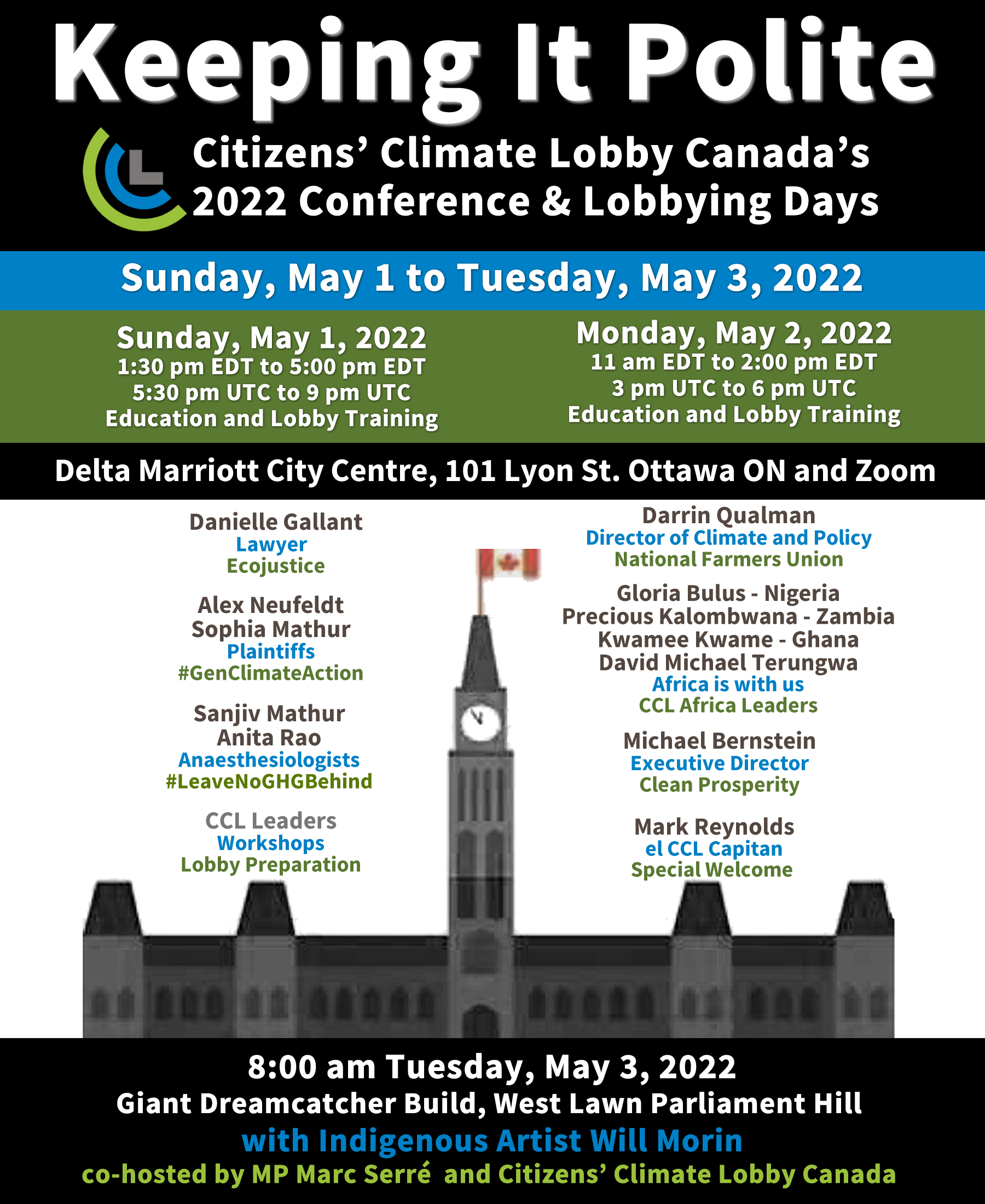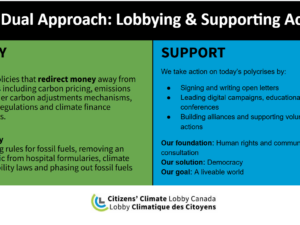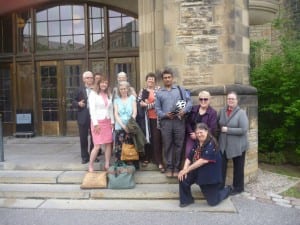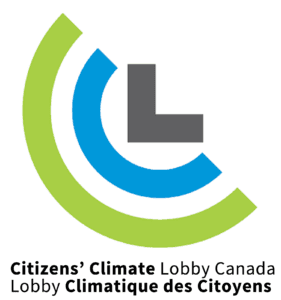Outline of Conference -Sunday and Monday
Day 1: Sunday, May 1, 2022, 1:30 pm EDT to 5:00 pm EDT
1:30 pm to 1:45 pm: Welcome and Land Acknowledgement
1:45 pm to 2:15 pm: Gen Climate Action Panel, Danielle Gallant, Alex Neufeldt and Sophia Mathur
2:30 pm to 3:00 pm: Pricing Pollution in the Operating Room Panel: Anita Rao and Sanjiv Mathur
3:15 pm to 3:55 pm: Workshop I, The Leave Behind
4:00 pm to 5:00 pm: Workshop II, Design Your Motivational Interviewing Questions Ottawa attendees
5:00 pm to 6:00 pm: Light meal
6:00 pm to 8:00 pm: Photos in and around Parliament Hill
Note, a separate Zoom Registration is required for Day 2 of this event.
Day 2: Monday, May 2, 2022, 11:15 am EDT to 2 pm EDT
11:15 am to 11:30 am: Welcome and special remarks from Mark Reynolds
11:30 am to 12:00 pm: Darrin Qualman – National Farmers Union
12:05 to 12:30 pm: Africa is with us: Kwamee Kwamee CCL Ghana leader, Gloria Bolus CCL Nigeria leader, Precious Kalombwa CCL Zambia Leader, and David Michael Terungwa – CCL Africa Coordinator
12:35 pm to 1:15 pm: Michael Bernstein – Canadians for Clean Prosperity
1:30 pm to 2:00 pm: Planning next steps for lobbying your MP in MayOttawa attendees
6:00 pm to 8:00 pm: Small reception at the Delta Marriott
Day 3: Tuesday, May 3, 2022
Lobbying in and around Parliament Hill
Giant Dreamcatcher Build on Parliament Hill with Indigenous Artist Will Morin
West Lawn on Parliament Hill
8:00 am Gathering in a Circle
8:05 am Start building a giant catcher together
9:00 am Winddown
Cohosted by Citizens’ Climate Lobby and MP Marc Serré (Nickel Belt)
Lobbying throughout the month of May
Lobbying Tool Kit
- Our 2022 Spring Lobbying Ask a.k.a The Leave Behind
- Spring 2022 CCL Canada LASER Talks
- Getting Your Group Ready to Lobby
- Lobbying 101 CCL Canada April 2022
- IMPORTANT Form to register your lobbying appointments – FILL IN
==========================================
Parliament Hill
- Currently, due to COVID restrictions, it is unlikely we will be invited into the halls of Parliament
- If by chance you are invited, a photo ID is required to get into all buildings on Parliament Hill.
- Allow at least 15 minutes to get through the airport-like security on Parliament Hill.
- Don’t wear and bring anything that looks remotely political such as flags and CCL swag (Climate Lobby are trigger words it seems) because it may be put in storage while you lobby in the building.
- Centre Block is under construction. Parliament debates in West Block and the Senate debate down at the old train station across from Chateau Laurier (not on the map below).
- The West Lawn of Parliament Hill is in front of West Block
- If by chance you get invited into the Parliamentary Dining Hall, men must wear a tie. No Jeans allowed.
Map of Parliament Hill which will be included in your conference booklet
More details coming soon.
Never Lobbied Before?
Never lobbied before? Don’t worry, we have been lobbying since 2010 in Canada. You will be empowered to speak for millions.
Before, during, and after the conference, you are going to meet with some of the best climate policy advocates on the planet. And we like to have fun. Getting out of our comfort zone is our modus operandi.
We have one overarching rule: treat politicians with respect and admiration for their service.
Here are the key strategies we have used since our very beginnings.
Why we are keeping it polite
We would like to first acknowledge the work of the land defenders on Turtle Island. Their work has given us the breathing room to focus on building the political will for a socially-responsible and economically-efficient policy that will wean our economy off of fossil fuels.
We started doing this work in 2010. We knew then it was going to take until the mid-2020s to get humanity on track.
And here we are. The narrow window of opportunity is now rapidly closing for successful mitigation of and adaptation to global climate destabilization (IPCC, February 2022). The April 2022 IPCC report offers a glimpse of how the global effort to mitigate climate change could be rapidly accelerated with the right impetus. The key is that people have to demand it.
We are truly in the fog of war and fossil fuels are literally fuelling conflicts. The impacts of the COVID pandemic, extreme weather events, compounded by ecological and food crises and conflicts have vividly exposed and reinforced structural inequalities based on gender, income, age, race, and disability.
It is best to keep calm and carry on. To do that, we know that we just need to keep our commander’s intent in mind. Our commander was Marshall Saunders. And he was very proud of our work in Canada. Marshall created a peaceful army. And Canadians brought our well-known politeness to his army. We can agree to disagree. In fact, it can be fun to disagree when we are polite. Truly, politeness is an element of a healthy democracy.
Marshall also focused on one policy, and we have it in Canada. Thus, in the midst of all this chaos, we are going to keep calm and lobby for improvements to Canada’s Greenhouse Gas Pollution Pricing Act and trust that others doing their work will get the job done.
We hope you can join us. You will be supported by some of the best volunteers on the planet. And because of our focus, you will have plenty of time to savour the planet while saving it. Marshall insisted savouring must come first too. He was the best commander ever.
Registration if attending virtually is now open.
The number of persons for the in-person conference will be restricted. So please watch your email carefully the week of April 4 if you plan to attend.
About Citizens' Climate Lobby Canada
Since 2010, CCL Canada has been lobbying parliamentarians for carbon fee and dividend. We have had 4000 letters to the editor, articles and opinion pieces published in newspapers by or about us, and we have lobbied parliamentarians over 1400 times.
At Citizens’ Climate Lobby, we’re committed to building the political will for the climate solutions we all need. As empowered citizens, we talk with neighbors, friends, and local officials about how national climate action can help ensure a healthy future while strengthening the Canadian economy.
 Our volunteers include high school students and concerned grandparents, a Canadian NASA rocket scientist living in Pasadena, health care workers from across Canada and many other walks of life. Some are PhD’s who have spent careers researching the intricacies of climate change; others are concerned citizens who just want to know how to help. Whatever our backgrounds, we’re all united by a commitment to making our voices heard as we call for a healthy climate future.
Our volunteers include high school students and concerned grandparents, a Canadian NASA rocket scientist living in Pasadena, health care workers from across Canada and many other walks of life. Some are PhD’s who have spent careers researching the intricacies of climate change; others are concerned citizens who just want to know how to help. Whatever our backgrounds, we’re all united by a commitment to making our voices heard as we call for a healthy climate future.
CCL is a non-partisan international organization. We know for a fact that citizens who are well-trained, organized by ridings and with a good system of support can influence the political process. We played a big role in the design of the Greenhouse Gas Pollution Pricing Act and we are continuing to do so.
Canadian Civics 101
CANADIAN CIVICS 101
For the benefit of our US American Friends
OVERVIEW: The USA is a democratic republic, whereas Canada is a constitutional monarchy. The President is the elected head of state in the USA. Queen Elizabeth II is our head of state, and she is represented in Canada by our Governor-General, Mary Simon. Our head of state is also called “the Crown”. Canada has a bicameral system, just like the USA, with lower and upper houses.
EXECUTIVE BRANCH: In Canada, the political party with the most seats in the House of Commons forms the government, and the leader of that party becomes the Prime Minister (PM). The executive branch of the Canadian government is led by the PM and he/she appoints senior Members of Parliament to the executive in a cabinet adhering to the principle of cabinet collective responsibility. The Privy Council is the non-partisan, public service support to the PM and Cabinet and its decision-making structures.
HOUSE OF COMMONS: Our lower house is called the House of Commons, and it is the Canadian equivalent of the US House of Representatives. Our federal representatives are elected in electoral districts which we call ridings. We have 338 electoral districts for 35 million people. Our federal representatives are called Members of Parliament or MPs. Until 2009, governments could call an election at any time within five years of being elected. Since 2009, we have legislated set election dates every four years, unless there is a non-confidence vote in the House of Commons that defeats the government and forces an election. This usually happens when we have minority governments.
MINORITY GOVERNMENTS A minority government happens when the ruling party does not have a majority of the seats in Parliament. Currently, we have a majority government under the Right Honourable Justin Trudeau (and yes, we add “u’s” to a lot of words up here). These recent governments were all minority governments: 2004-2006, 2006-2008, 2008-2011, 2019-2021 and present. Like in the USA and Britain, Canadian MPs are among the last representatives elected using a first-past-the-post ballot which many Canadians hope will change to some form of proportional representation.
THE CANADIAN SENATE: The Canadian Senate, unlike in the USA, is not elected. It is an appointed senate. Most senators hold their seat until the mandatory age of retirement. There are three types of senators in Canada: Independents, Liberals and Conservatives. Currently, Independents and Liberals combined in the Senate are in a majority. The Senate is divided equally among four geographic regions: 24 for Ontario, 24 for Quebec, 24 for the Maritime (10 for Nova Scotia, 10 for New Brunswick, and four for Prince Edward Island), and 24 for the Western provinces (six each for Manitoba, British Columbia, Saskatchewan, and Alberta). Newfoundland and Labrador, which became a Canadian province in 1949, is represented by six senators. Further, Canada’s three territories—the Northwest Territories, Yukon, and Nunavut—are allocated one senator each. An additional four or eight senators may be temporarily appointed by the Governor-General, provided the approval of the Queen is secured, and the four divisions are equally represented, thus putting the maximum possible number of senators at 113.
THE DOMINATE BRANCH: The House of Commons is the dominant branch of parliament, with the Senate and the Crown rarely opposing its will. The Senate is meant to take a second sober look at bills before they pass into law. The Senate reviews legislation from a less partisan standpoint, and the Governor-General provides the necessary Royal Assent to make bills into law.
POWERS OF A MAJORITY GOVERNMENT: The Canadian Prime Minister in a majority government has powers that a US president could only dream of because she/he has complete control over the executive and the House of Commons for four years (we don’t have midterm elections in Canada) and they are rarely opposed by the senate or the Governor-General. Currently, the NDP and the Liberals have signed an agreement to cooperate for the next four years.














